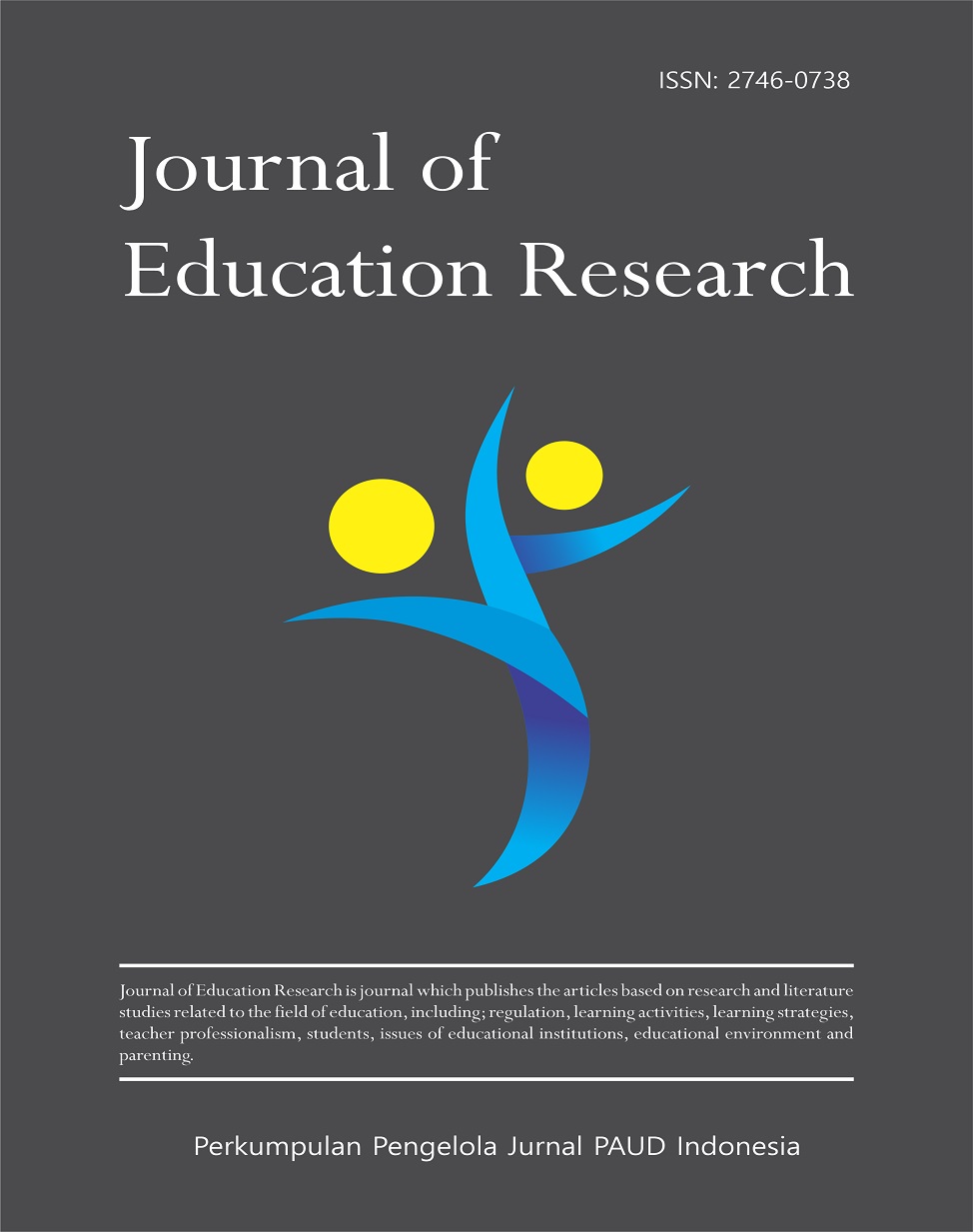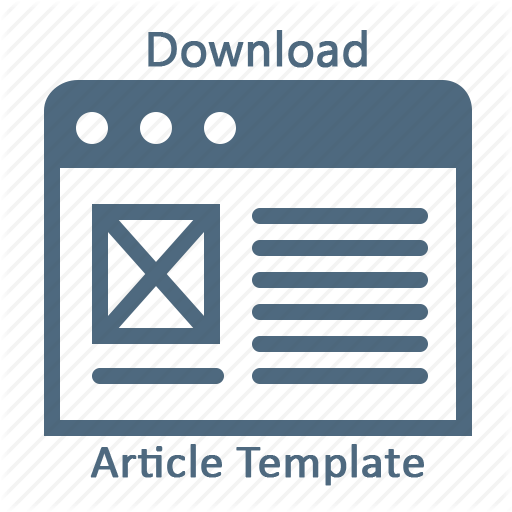Pengembangan Instrumen Pengukuran Keterampilan Kolaborasi Terintegrasi Nilai Pendidikan Islam Abad 21 Siswa Sekolah Menengah Pertama Islam
DOI:
https://doi.org/10.37985/jer.v6i3.2254Keywords:
Keterampilan kolaborasi, nilai Islam, Pendidikan Agama IslamAbstract
Penelitian ini bertujuan untuk mengembangkan instrumen pengukuran keterampilan kolaborasi yang terintegrasi dengan nilai-nilai pendidikan Islam dalam pembelajaran abad ke-21, dan menawarkan pendekatan baru dibandingkan instrumen sebelumnya yang belum mengakomodasi aspek integrasi nilai Islami secara komprehensif. Penelitian menggunakan metode survei dengan teknik cluster random sampling, melibatkan siswa Sekolah Menengah Pertama Islam di Jakarta. Data dikumpulkan menggunakan skala Likert lima tingkat. Validitas isi diuji oleh panel ahli menggunakan Content Validity Ratio (CVR) dan Content Validity Index (CVI), sedangkan validitas konstruk diuji melalui analisis faktor eksploratori (EFA). Hasil menunjukkan validitas isi yang tinggi (CVI > 0,9), konsistensi internal yang sangat baik (Cronbach's Alpha = 0,949) dan mengidentifikasi lima dimensi keterampilan kolaborasi. Dengan validitas dan reliabilitas yang tinggi, instrumen ini menjadi alat yang andal untuk mengevaluasi keterampilan kolaborasi siswa berbasis nilai Islam. Instrumen ini memiliki implikasi praktis dalam pendidikan Islam abad ke-21, yaitu mendukung pendidik dalam merancang strategi pembelajaran yang efektif untuk meningkatkan keterampilan kolaborasi siswa, sekaligus mengintegrasikan nilai-nilai Islam secara mendalam dalam proses pendidikan, sehingga menciptakan generasi yang kompeten secara global dan berkarakter Islami.
Downloads
References
Ad-Damasyqi, I. bin U. bin K. al-Q. (2004). Tafsir Ibnu Katsir (M. A. Ghoffar, A. Mu’thi, & A. A.-A. Ihsan (trans.)). Pustaka Imam Syafi’i.
Almathami, H. K. Y., Win, K. T., & Vlahu-Gjorgievska, E. (2022). Development and validation of a new tool to identify factors that influence users’ motivation toward the use of teleconsultation systems: A modified Delphi study. International Journal of Medical Informatics, 157, 104618. https://doi.org/10.1016/J.IJMEDINF.2021.104618
Almohanna, A. A. S., Win, K. T., Meedya, S., & Vlahu-Gjorgievska, E. (2022). Design and content validation of an instrument measuring user perception of the persuasive design principles in a breastfeeding mHealth app: A modified Delphi study. International Journal of Medical Informatics, 164, 104789. https://doi.org/10.1016/J.IJMEDINF.2022.104789
Anwar, S., & Salim, A. (2019). Pendidikan Islam Dalam Membangun Karakter Bangsa Di Era Milenial. Al-Tadzkiyyah Jurnal Pendidikan Islam, 9(2), 233. https://doi.org/10.24042/atjpi.v9i2.3628
Aziz, A. A., Hidayatullah, A. S., Ruswandi, U., & Arifin, B. S. (2021). Pembelajaran Pendidikan Agama Islam (PAI) Di Sekolah Dasar. Jurnal Penelitian Pendidikan Islam, 9(1), 63. https://doi.org/10.36667/jppi.v9i1.542
Azwar, S. (2012). Penyusunan Skala Psikologi (2nd ed.). Pustaka Pelajar.
Boland, V., Drury, A., & Brady, A.-M. (2022). CN58 Mapping the measurement of lymphoma survivors’ unmet needs and quality of life outcomes: Evidence for a lymphoma-specific questionnaire. Annals of Oncology, 33, S1371–S1371. https://doi.org/10.1016/j.annonc.2022.07.381
Brown, J. A., Cooper, A. L., & Albrecht, M. A. (2020). Development and content validation of the Burden of Documentation for Nurses and Midwives (BurDoNsaM) survey护士和助产士文件记载负担调查的开展和内容验证. Journal of Advanced Nursing, 76(5), 1273–1281. https://doi.org/10.1111/JAN.14320
Brown, J. N., Blumhardt, S., Lostak, B., Acorda, D., Weissbrod, P. A., Henningfeld, J. K., Gavini, S., Anani, A. O., Brown, A., Raol, N. P., Sterling, L., Jiwani, A., Bedwell, J. R., & Ongkasuwan, J. (2024). Transitions of care: An aerodigestive provider assessment survey. International Journal of Pediatric Otorhinolaryngology, 180, 111933. https://doi.org/10.1016/J.IJPORL.2024.111933
Elangovan, N., & Sundaravel, E. (2021). Method of preparing a document for survey instrument validation by experts. MethodsX, 8, 101326. https://doi.org/10.1016/J.MEX.2021.101326
Gwadabe, U. M., Arumugam, N., & Amirah, N. A. (2022). Exploration and Development of Measurement Items of Innovation for New Technology Adoption among Small Farmers. Universal Journal of Agricultural Research, 10(6), 620–626. https://doi.org/10.13189/ujar.2022.100603
Hasnah, S. (2023). Implementasi Nilai-Nilai Islam Dalam Pendidikan Jasmani Dan Olahraga Untuk Membentuk Karakter Ulul Albab. At Ta Dib, 18(1), 18–27. https://doi.org/10.21111/attadib.v18i1.9909
Hermawan, H., Siahaan, P., Suhendi, E., Kaniawati, I., Samsudin, A., Setyadin, A. H., & Hidayat, S. R. (2017). Desain Instrumen Rubrik Kemampuan Berkolaborasi Siswa SMP dalam Materi Pemantulan Cahaya. Jurnal Penelitian & Pengembangan Pendidikan Fisika, 3(2), 167–174. https://doi.org/10.21009/1.03207
Imelda, A. (2018). Implementasi Pendidikan Nilai Dalam Pendidikan Agama Islam. Al-Tadzkiyyah Jurnal Pendidikan Islam, 8(2), 227. https://doi.org/10.24042/atjpi.v8i2.2128
Irfan, M. N. (2024). Analisis Komponen Utama pada Data Diabetes. Sciencestatistics: Journal of Statistics, Probability, and Its Application. https://api.semanticscholar.org/CorpusID:271227239
Kyriazos, T. (2018). Applied Psychometrics: The 3-Faced Construct Validation Method, a Routine for Evaluating a Factor Structure. Psychology, 09, 2044–2072. https://doi.org/10.4236/psych.2018.98117
L’Ecuyer, K. M., Subramaniam, D. S., & Reangsing, C. (2020). Development of the preceptor self-assessment tool and use of the content validity index. Journal of Continuing Education in Nursing, 51(10), 469–476. https://doi.org/10.3928/00220124-20200914-09
Mardhiyah, R. H., Aldriani, S. N. F., Chitta, F., & Zulfikar, M. R. (2021). Pentingnya Keterampilan Belajar Di Abad 21 Sebagai Tuntutan Dalam Pengembangan Sumber Daya Manusia. Lectura Jurnal Pendidikan, 12(1), 29–40. https://doi.org/10.31849/lectura.v12i1.5813
Marwahningsih, N. (2023). Mengintegrasikan Kecakapan Abad 21 Dalam Rencana Pelaksanaan Pembelajaran Harian. Murhum Jurnal Pendidikan Anak Usia Dini, 4(2), 94–104. https://doi.org/10.37985/murhum.v4i2.296
Maulana, M. A., & Mediatati, N. (2023). Penerapan Model Project Based Learning Melalui Pendekatan Culturally Responsive Teaching Untuk Meningkatkan Kolaborasi dan Hasil Belajar Siswa. Literasi (Jurnal Ilmu Pendidikan), 14(3), 153. https://doi.org/10.21927/literasi.2023.14(3).153-163
Muspiroh, N. (2016). INTEGRASI NILAI ISLAM DALAM PEMBELAJARAN IPA (Perspektif Pendidikan Islam). Jurnal Pendidikan Islam, 28(3), 484. https://doi.org/10.15575/jpi.v28i3.560
Nurdin, N., Anhusadar, L., Herlina, H., & Nurhalimah, S. (2021). Strategi Kepala Sekolah Dalam Pelaksanaan Ujian Nasional Berbasis Komputer (UNBK) Di Sekolah Menengah Pertama. Al-Ta Dib Jurnal Kajian Ilmu Kependidikan, 14(1), 1. https://doi.org/10.31332/atdbwv14i1.1901
Patimah, L. (2017). Redesain Pembelajaran Pendidikan Islam Dalam Perspektif Pembelajaran Abad 21. Jurnal JPSD (Jurnal Pendidikan Sekolah Dasar), 3(2), 34. https://doi.org/10.26555/jpsd.v3i2.a7360
Prananto, I. W., Rakhmawati, Y., & Pamungkas, T. (2022). Content Validity Ratio (CVR), Content Validity Index (CVI), and Confirmatory Factor Analysis (CFA) in Mathematics Learning Independence Instruments. Kontinu: Jurnal Penelitian Didaktik Matematika, 6(8), 14–20. https://doi.org/10.56304/s0040363622080021
Purnamasari, I., Rahmawati, Noviani, D., & Hilmin. (2023). Pendidikan Islam Transformatif. Ihsanika: Jurnal Pendidikan Agama Islam, 01(4), 1–22. https://doi.org/10.59841/ihsanika.v1i4.562
Purwanto, D. (2018). Analisis Faktor: Konsep, Prosedur Uji Dan Interpretasi. Jurnal Teknodik, 4(15 SE-Articles), 153–169. https://doi.org/10.32550/teknodik.v4i15.388
Rahayu, R., Iskandar, S., & Abidin, Y. (2022). Inovasi Pembelajaran Abad 21 Dan Penerapannya Di Indonesia. Jurnal Basicedu, 6(2), 2099–2104. https://doi.org/10.31004/basicedu.v6i2.2082
Raykov, T., Anthony, J. C., & Menold, N. (2022). On the Importance of Coefficient Alpha for Measurement Research: Loading Equality Is Not Necessary for Alpha’s Utility as a Scale Reliability Index. 83(4), 766–781. https://doi.org/10.1177/00131644221104972
Saavedra, A. R., & Opfer, V. D. and wang. (2012). Teaching and Learning 21 st Century Lesson from the Learning Sciences. Asia Society, Partnership for Global Learning. 1-35. APERA Conference, April, 1–35. https://www.aare.edu.au/data/publications/2012/Saavedra12.pdf
Sari, L. M. (2019). Evaluasi Dalam Pendidikan Islam. Al-Tadzkiyyah Jurnal Pendidikan Islam, 9(2), 211. https://doi.org/10.24042/atjpi.v9i2.3624
Shi, J., Mo, X., & Sun, Z. (2012). [Content validity index in scale development]. Zhong nan da xue xue bao. Yi xue ban = Journal of Central South University. Medical sciences, 37(2), 152–155. https://doi.org/10.3969/j.issn.1672-7347.2012.02.007
Shrotryia, V. K., & Dhanda, U. (2019). Content Validity of Assessment Instrument for Employee Engagement. SAGE Open, 9(1).
Soleh, A. R., & Arifin, Z. (2021). Integrasi Keterampilan Abad 21 Dalam Pengembangan Perangkat Pembelajaran Pada Konsep Community of Inquiry. Qalamuna Jurnal Pendidikan Sosial Dan Agama, 13(2), 473–490. https://doi.org/10.37680/qalamuna.v13i2.995
Susilawati, N., Sobarna, N. A., & Pratikno, H. (2023). Pendidikan Profetik Dalam Novel Bumi Cinta Karya Habiburrahman El Shirazy Dan Implikasinya Pada Capaian Pembelajaran PAI Kurikulum Merdeka. Bandung Conference Series Islamic Education, 3(1). https://doi.org/10.29313/bcsied.v3i1.6361
Trilling, B., & Fadel, C. (2009). 21st century skills learning for life in our times. Journal of Sustainable Development Education and Research.
Watkins, M. W. (2018). Exploratory Factor Analysis: A Guide to Best Practice. Journal of Black Psychology, 44(3), 219–246. https://doi.org/10.1177/0095798418771807
Wright, R. I. (1980). Instrument reliability. Journal of Physics E: Scientific Instruments, 13(1), 8–16. https://doi.org/10.1088/0022-3735/13/1/001
Yun, V. W. S., Ulang, N. M., & Husain, S. H. (2023). Enhancing Content Validity of the Designed Hierarchy of Controls Instrument in Preventing Infectious Diseases on Construction Sites: A Multidimensional Approach. Journal of Advanced Research in Applied Sciences and Engineering Technology, 32(2), 508–521. https://doi.org/10.37934/ARASET.32.2.508521
Downloads
Published
How to Cite
License
Copyright (c) 2025 Muhamad Heru Hermawan, Soeharno Soeharno, Wawan Supriadi, Awaluddin Tjalla, Lussy Dwiutami Wahyuni

This work is licensed under a Creative Commons Attribution-ShareAlike 4.0 International License.
Authors who publish with this journal agree to the following terms:
- Authors retain copyright and grant the journal right of first publication with the work simultaneously licensed under a Creative Commons Attribution-ShareAlike 4.0 International License that allows others to share the work with an acknowledgement of the works authorship and initial publication in this journal.Â
- Authors are able to enter into separate, additional contractual arrangements for the non-exclusive distribution of the journals published version of the work (e.g., post it to an institutional repository or publish it in a book), with an acknowledgement of its initial publication in this journal.
- Authors are permitted and encouraged to post their work online (e.g., in institutional repositories or on their website) prior to and during the submission process, as it can lead to productive exchanges, as well as earlier and greater citation of published work (See The Effect of Open Access).









